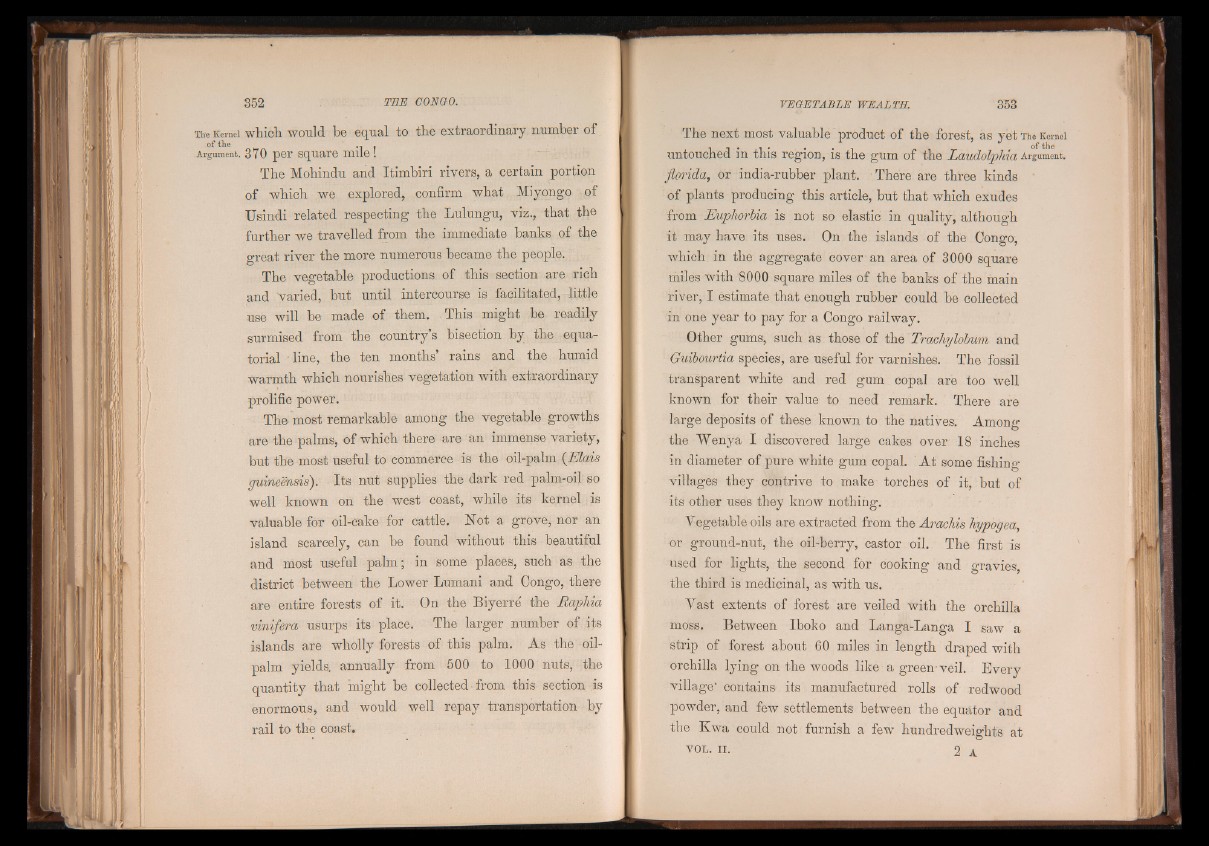
The Kernel which would be equal to the extraordinary number of
of the » Argument. 370 per square mile I
The Mohindu and Itimbiri rivers, a certain portion
of which we explored, confirm what Miyongo of
Usindi related respecting the Lulungu, viz., that the
further we travelled from the immediate banks of the
great river the more numerous became the people.
The vegetable productions of this section are rich
and varied, but until intercourse is facilitated,-little
use will be made of them. This might be readily
surmised from the country’s bisection by the equatorial
line, the ten months’ rains and the humid
warmth which nourishes vegetation with extraordinary
prolific power.
The most remarkable among the vegetable growths
are the palms, of which there are an immense variety,
but the most useful to commerce is the oil-palm (Elais
guineensis). Its nut supplies the dark red palm-oil so
well known on the west coast, while its kernel is
valuable for oil-cake for cattle. Not a grove, nor an
island scarcely, can be found without this beautiful
and most useful palm; in some places, such as the
district between the Lower Lumani and Congo, there
are entire forests of it. On the Biyerre the Eaphia
vinifera usurps its place. The larger number of its
islands are wholly forests of this palm. As the oil-
palm yields, annually from 500 to 1000 nuts, the
quantity that might be collected from this section is
enormous, and would well repay transportation by
rail to the coast.
The next most valuable product of the forest, as yet The Kernel
untouched in this region, is the gum of the Laudolphia Argument,
florida, or india-rubber plant. There are three kinds
of plants producing this article, but that which exudes
from Euphorbia is not so elastic in quality, although
it may have its uses. On the islands of the Congo,
which in the aggregate cover an area of 3000 square
miles Avith 8000 square miles of the banks of the main
river, I estimate that enough rubber could be collected
in one year to pay for a Congo railway.
Other gums, such as those of the Trachylobum and
Guibourtia species, are useful for varnishes. The fossil
transparent white and red gum copal are too well
known for their value to need remark. There are
large deposits of these known to the natives. Among
the Wenya I discovered large cakes over 18 inches
in diameter of pure white gum copal. ' At some fishing
villages they contrive to make torches of it, but of
its other uses they know nothing.
Vegetable oils are extracted from the Arachis hypogea,
or ground-nut, the oil-berry, castor oil. The first is
used for lights, the second for cooking and gravies
the third is medicinal, as with us.
Vast extents of forest are veiled with the orchilla
moss. Between Iboko and Langa-Langa I saw a
strip of forest about 60 miles in length draped with
orchilla lying on the woods like a green-veil. Every
village" contains its manufactured rolls of redwood
powder, and few settlements between the equator and
the Kwa could not furnish a few hundredweights at